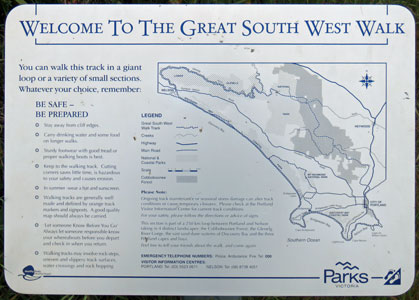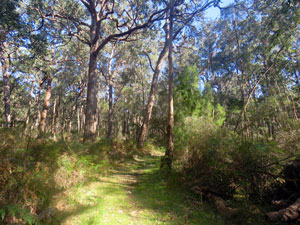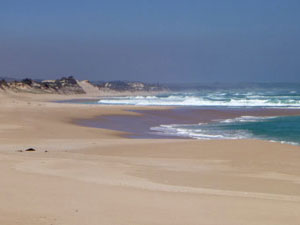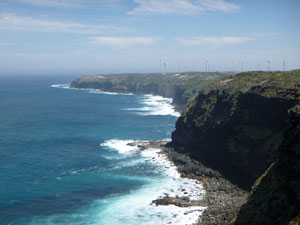| Great South West Walk |
About |
The Great South West Walk is a relatively recent track that, as its name suggests, lies in the south-western corner of the state of Victoria. It's existence is a tribute to community endeavour and perseverance. The idea for this walk was first conceived in 1980 by Sam Bruton, then Chief District Ranger with the Victorian Department of Conservation. While looking over maps of the area, he was struck by the four unique walking landscapes of the local region - forest, river, beach, capes and bays - and saw the possibility of a long-distance trail that would showcase these features. Given the benefits of such a track to educate and enthuse people about the environment, he approached the principal of Portland High School, Bill Golding, to join him in the project. These two are the fathers of the Great South West Walk. With the support of State government departments and local land-owners, work was commenced in 1981, largely by a group of volunteers (many from Portland High School) and a 200 km trail was officially opened in late 1983. The volunteers formed a "Friends of the Great South West Walk" association that continues to promote, maintain and improve the track to this day. In the early 1990s, they extended the track to its full length of 250 km to complete a circuit walk from Portland to Portland that passes through three National and two State Parks. |
|
|
The walk now comprises a well-marked route interspersed by 14 excellent campsites, offering a shelter, rainwater-tank, eco-toilet and fire-pit, to guide walkers through four distinct stages - the Cobobboonee forest, along the Glenelg River, along the isolated beaches of Discovery Bay and around the cliffs and headlands of Capes Bridgewater and Nelson. In fact, the walk is promoted as Nature's very own symphony in four parts - forest, river, beach and capes. Thus, we have travelled to this part of Victoria to "hear the music" [see footnote]. While the circuit officially starts and ends in Portland, we opted to start and finish in the village of Nelson (normally the half-way point). This meant that we could complete the Great South West Walk in a somewhat different manner - by canoeing for the last 3½ days down the Glenelg River instead of walking along its banks. It would mean that we would be listening to the movements of the symphony in a different order, but I suspect that will be of little consequence. So settle back, as we raise our batons and guide you through our interpretation of the Great South West Walk and Symphony. |
|
|
Footnote: You really can hear the music, as the Great South Coast Walk is probably the only walking track that has inspired an orchestral composition. In 2007, the composer Dindy Vaughan was commissioned to write a choral symphony in four movements. The symphony "Discovery" premiered in Portland in 2008. The Symphony is in four movements, celebrating the ancient history, and modern construction of this 250km walk.
|
Food drop day |
As mentioned above, the Great South Coast Walk is 250 km long, and any long distance walk requires careful planning, especially if, like us, you don't want to carry more weight than you have to. Thus, the day before we set out became "food drop day". The fair Nello, our friend Alan and I had arrived in Nelson, a small village near the mouth of the Glenelg River in western Victoria, the night before and installed ourselves in Keg Cottage, a somewhat dilapidated, but character-filled adjunct to the Nelson pub. It provided a good place to finish packing our food-boxes for the trip. Already full of home-cooked vacuum-sealed dehydrated food packages, instant oats packets, assorted lunches, spare gas bottles etc etc, they needed just a bit of fresh fruit for the occasional treat to be ready. Two lots of boxes were for indoor storage and a couple of cardboard boxes sufficed for that. The others were for food stashes in the open and consisted of duct-taped panels of 1 mm thick high-density polypropylene - hard enough to keep out vermin and light enough to collapse and carry out. |
|
The first stop was a quick one, just across the river to the canoe hire people, where we left two of the cardboard boxes with food for three nights. These would be brought up to Moleside campsite later with our canoe and kayak for the final leg of our adventure - a 4-day canoe trip down the Glenelg River from Moleside to our starting point at Nelson. Then, leaving the fair Nello to enjoy the sunshine at Nelson, Alan and I set out by car to drop a two-day stash at the Monibeong Lake campsite, our first stop on the walk. Now why would you be so silly as to do a food stash so early. Well, we also hid our camping and cooking gear there, which meant that we could do the first 22 km (a long day) of mainly beach-walking with a relatively light load in our backpacks. Then it was on to The Springs, our third camp out. Here, there was no vehicle access, so we found a point two kilometres before the campsite, where we could access the track and left our next food stash there, hidden in the cliff-top scrub with glorious views to the west over Discovery Bay. This stash would be sufficient to get us to Portland in three days time, where we planned to stay at the local tourist park cabins and take a day off. The tourist park was an obvious choice to leave our next box of supplies. |
 Stash #2 - looks fairly well hidden |
|
 |
Two days walking out of Portland is the Cut Out campsite, set deep in the eucalypt forest. It required a bit of a walk back down the track from one of the dirt roads that intersect the forest to reach the campsite and hide this stash in the undergrowth near it. It would be enough to get us to Moleside in two days time where the canoe-hire person would deliver boats and food for out final canoe leg. Thus the supply chain was completed, and we headed back to Keg Cottage to enjoy a well-earned beer and get ready for the real action - the Great South West Walk and Canoe adventure was about to begin. |
|










